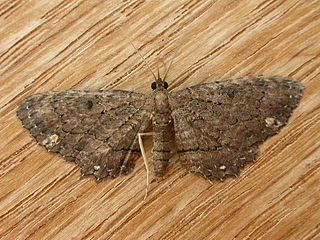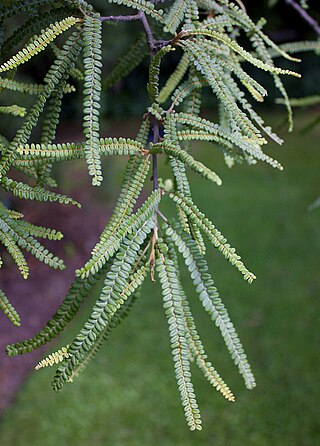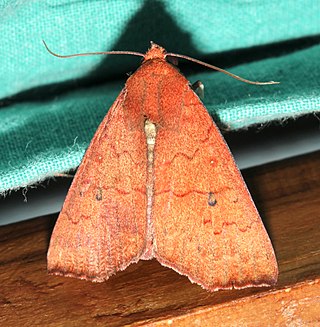
The bamboo bats are a genus of vesper bats in the genus Tylonycteris. The name translates as "padded bat", and refers to the presence of hairless fleshy pads on the hands and feet, which the bats use to help them grip onto bamboo.

Hyposmocoma fulvida is a species of moth of the family Cosmopterigidae. It was first described by Lord Walsingham in 1907. It is endemic to the Hawaiian islands of Kauai and Molokai.

Eccymatoge fulvida is a moth of the family Geometridae first described by Alfred Jefferis Turner in 1907. It is known from Australia.

Austroderia is a genus of five species of tall grasses native to New Zealand, commonly known as toetoe. The species are A. toetoe, A. fulvida, A. splendens, A. richardii and A. turbaria. They were recently reclassified in 2011 from the genus Cortaderia, although their distinctiveness had been recognized as early as 1853.

Deinypena fulvida is a moth of the family Erebidae first described by William Jacob Holland in 1920. It is found in the Democratic Republic of the Congo.

Sophora fulvida, the kōwhai or west coast kōwhai is one of 8 species of native Sophora or kōwhai in New Zealand and grows naturally around the Northland, Auckland and Waikato regions of New Zealand.
Serixia is a genus of longhorn beetles of the subfamily Lamiinae, containing the following species:
Eunidia fulvida is a species of beetle in the family Cerambycidae. It was described by Francis Polkinghorne Pascoe in 1856, originally under the genus Anomoesia.
Serixia buruensis is a species of beetle in the family Cerambycidae. It was described by Stephan von Breuning in 1958.
Serixia cinereotomentosa is a species of beetle in the family Cerambycidae. It was described by Stephan von Breuning in 1958.
Serixia novaebritanniae is a species of beetle in the family Cerambycidae. It was described by Stephan von Breuning in 1958.
Serixia fumosa is a species of beetle in the family Cerambycidae. It was described by Francis Polkinghorne Pascoe in 1867. It is known from Sumatra and Borneo.
Serixia literata is a species of beetle in the family Cerambycidae. It was described by Francis Polkinghorne Pascoe in 1858. It is known from Malaysia, Borneo and Sulawesi.
Serixia longicornis is a species of beetle in the family Cerambycidae. It was described by Francis Polkinghorne Pascoe in 1858.
Serixia prolata is a species of beetle in the family Cerambycidae. It was described by Francis Polkinghorne Pascoe in 1858.
Serixia sedata is a species of beetle in the family Cerambycidae. It was described by Francis Polkinghorne Pascoe in 1862.
Serixia phaeoptera is a species of beetle in the family Cerambycidae. It was described by Per Olof Christopher Aurivillius in 1927.
Serixia trigonocephala is a species of beetle in the family Cerambycidae. It was described by Heller in 1915.

Anomis fulvida is a moth of the family Erebidae first described by Achille Guenée in 1852. It is found in Australia, African countries like Sierra Leone, South Africa, Tanzania, and Asian countries like Sri Lanka.

Austroderia fulvida, the toetoe, is a species of grass in the family Poaceae, native to New Zealand. As its synonym Cortaderia fulvida it has gained the Royal Horticultural Society's Award of Garden Merit as an ornamental.







